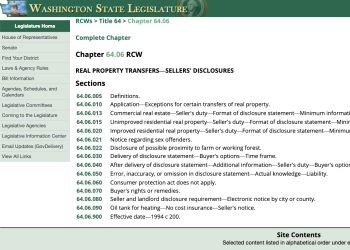The Seller Disclosure Statement is required in the state of Washington. The seller must provide a buyer of his home or land a Form 17 Seller Disclosure Statement. The disclosure is an attempt to help consumers (buyers) avoid intentional seller misrepresentation. There is also an attempt to address unintentional seller misrepresentation, which is tort law rather than contract law. You’ll see in this video how this seller disclosure statement has not helped consumers very much, if at all, and there is a better answer to help buyers find out about defects in a property.
Seller Disclosure Statement
Seller Disclosure Statement Issues
Sellers can answer questions on the seller disclosure statement with a “yes,” “no,” or “don’t know.” Of course, the vast majority of sellers answer all the questions honestly and to the best of their ability. But let’s not be naive. Not everyone in the world is perfectly honest and not all homeowners are going to tell a buyer about some minor (or major) defect that could destroy the potential sale of the property. As an attorney I did litigate seller misrepresentation issues in many trials, and I can tell you that there are in fact a few dishonest people out there. But this seller disclosure statement does not solve seller misrepresentation.
Seller Disclosure Statement Disclosures
The seller can avoid liability in most cases by simply marking “don’t know” on any question that he might deny he knew and that could chase a buyer away. The challenge is that if a seller wants to hide an important piece of information, and he marks “don’t know” on the seller disclosure statement, it is almost impossible to prove that he did know in a court when you are subject to the restrictions of the rules of procedure. You can’t get in someone’s head, and so it is a practical impossibility to prove the seller knew and intentionally withheld that information to the buyer’s detriment.
 As I suggest in this video, the answer is to do what all wise buyers have always done and continue to do: Buyers should conduct their own due diligence of a property with the proper addendums and contingencies, and that involves hiring professionals to examine and find any defects in the property, inside or outside. Buyers should carefully read the seller disclosure statement the seller gives them but should do their own due diligence.
As I suggest in this video, the answer is to do what all wise buyers have always done and continue to do: Buyers should conduct their own due diligence of a property with the proper addendums and contingencies, and that involves hiring professionals to examine and find any defects in the property, inside or outside. Buyers should carefully read the seller disclosure statement the seller gives them but should do their own due diligence.
Last Updated on September 4, 2011 by Chuck Marunde



























